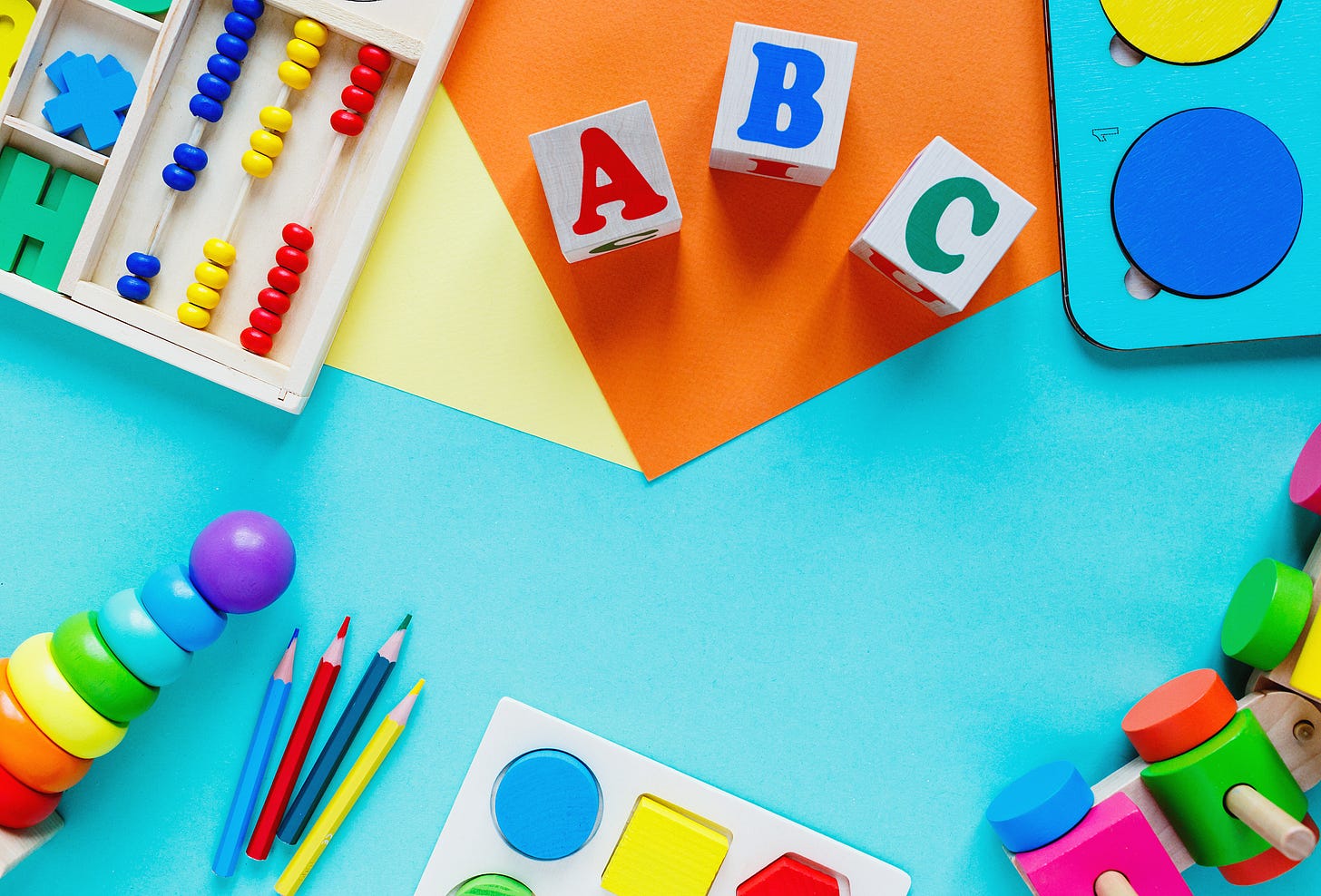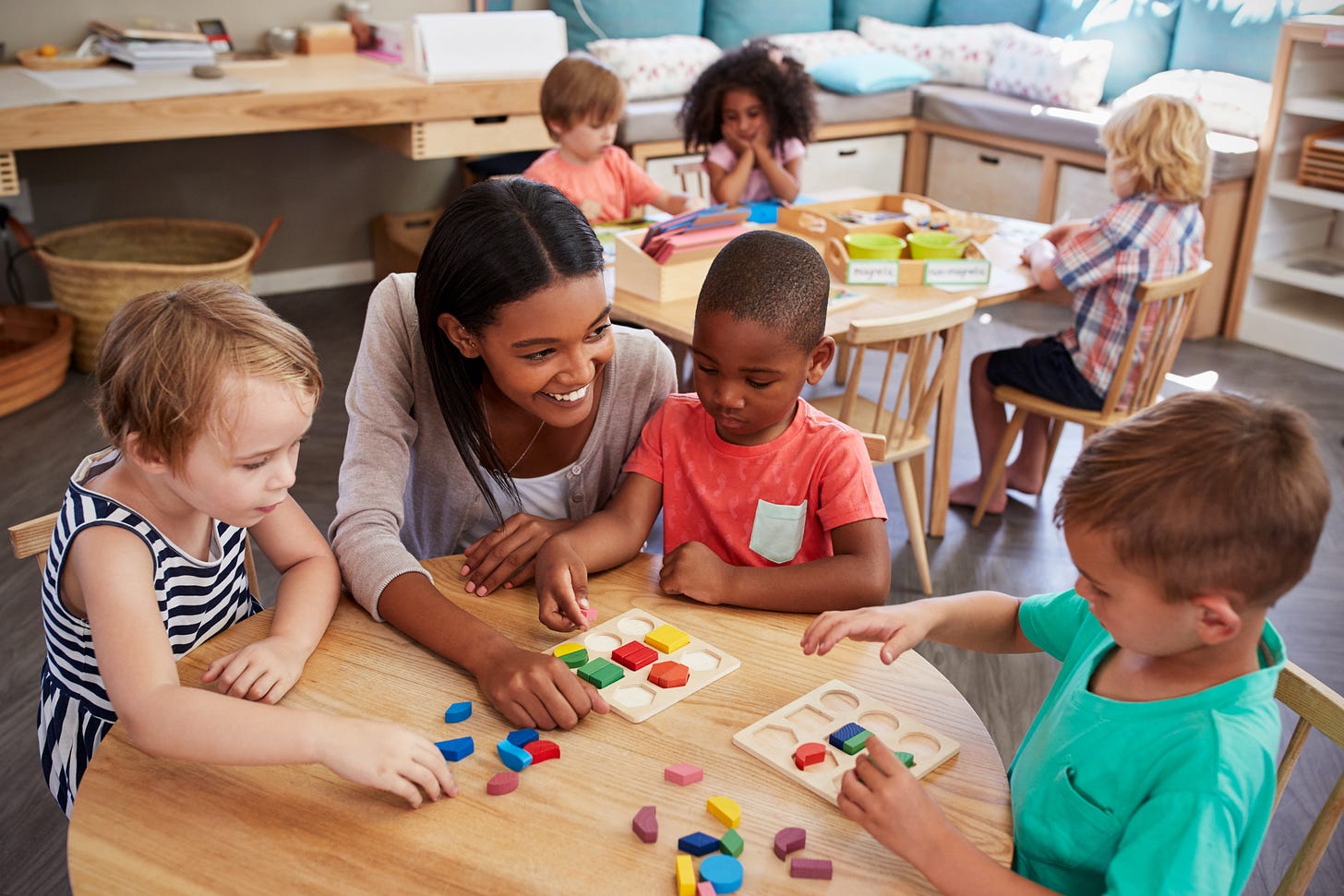What Makes Pre-K Good or Bad?
What the science says about what works — and why we aren't doing more of it
Unless you’ve been living in a bubble the past few weeks — which, let’s face it, many of us have — you’ve probably heard about the surprising new study reporting that kids randomly chosen by lottery to attend a state-funded pre-K program in Tennessee ended up with lower test scores in third through sixth grade compared with kids who did not attend. Considering that the whole point of universal pre-K is to give kids a leg up — as President Biden asserted on Twitter, “studies show that the earlier our children begin to learn in school, the better” — this is a disheartening result, to say the least. Does it mean pre-K doesn’t actually help kids?
As you might guess, the answer is complicated. For one thing, this is just one study, and we always have to consider the broader literature base. In her newsletter last week, Emily Oster discussed why we might want to take this particular finding with a grain of salt — because while it was a well-conducted study, it doesn’t align with decades research on this question. And generally — though there are exceptions — we should trust a consensus more than the single study that contradicts it.
Still, other studies have raised questions about the overall benefits of state-run preschool and childcare, and collectively they suggest that recently implemented programs are not as helpful as some of the early programs tested decades ago. But why? One thing we know from the research is that the quality of the program matters — what kids do in pre-K makes a big difference. If we’re going to discuss the benefits or drawbacks of universal pre-K (or of any particular preschool, for that matter), we have to consider what it actually looks like. And today, some programs just don’t look so great. They’re designed with short-sighted goals in mind, even though the science tells us that they aren’t going to help kids in the long run.
One key problem is that we are not putting nearly enough public money into early childhood education. According to a 2021 report from the U.S. Department of the Treasury, the U.S. spends a smaller proportion of its gross domestic product on early childhood education than almost every other developed country — on this measure, it ranks 35th out of 37 countries tracked by the Organization for Economic Co-Operation and Development (OECD). France invests the equivalent of $7,400 per infant to 5-year-old child, while the U.S. invests only $2,400. (For comparison, the U.S. spends about four times that per child aged 5 to 18.)
That’s just embarrassing — it means that we can’t pay early childhood educators well, and we can’t train them well, either. And that means that no matter how much we try, we probably aren’t going to end up with stellar pre-K programs across the board.
Another key problem is that many schools aren’t using pedagogical strategies that actually work. That’s partly a funding issue, yes, but it’s also because the pressure to “achieve” has been trickling down younger and younger, and, to put it bluntly, totally screwing things up. I won’t get into all the history here, but one of the key culprits was No Child Left Behind, which created an immense frenzy around standardized test scores, causing teachers to fear for their jobs if they didn’t spend every minute of every day teaching to the tests.
Samuel Meisels, the founding executive director of the Buffett Early Childhood Institute at the University of Nebraska, told me for a piece I wrote for Scientific American Mind that because of No Child Left Behind, “We saw an increase in expectations for what children would be able to do early on in school, and that resulted in a downward extension of these academic demands through the primary grades and then, eventually, into early childhood.”
As I wrote in a 2020 New York Times article about kindergarten:
It didn’t used to be this way. In a 2016 study, researchers from the University of Virginia analyzed kindergarten classrooms and teacher expectations in public schools in the United States from 1998 and compared them to those in 2010. While only 29 percent of the 2,500 teachers surveyed in 1998 thought parents needed to ensure their kids knew the alphabet before kindergarten, 62 percent of the 2,700 surveyed in 2010 thought so.
The school routines of kindergarteners have changed too: Over the 12 years covered in the study, kindergarteners began spending less time on music, art, dance and theater, and more time doing worksheets. Time doing child-led activities — such as reading, playing with Legos, or doing arts and crafts — dropped, while teacher-directed instruction rose. The findings paint a clear picture: Kindergarten involves a lot more academic instruction than it used to, and teacher expectations have grown.
Ultimately, far too many preschoolers (and early elementary schoolers) are spending their days doing rote learning and worksheets. This is not developmentally appropriate. And we know it doesn’t actually help kids learn or thrive. It only stifles their curiosity and creativity.
So what does actually work? Instead of focusing on academic instruction, schools should be letting kids play and organizing child-centered (rather than teacher-centered) class activities. One of the first studies to show that preschool can be helpful came from the Abecedarian Project, a study undertaken by researchers in North Carolina starting in 1972. In the study, high-risk (often low-income) babies and toddlers were randomly assigned to receive regular childcare and preschool from infancy to age 5. Compared with similar kids who didn’t attend the program, the Abecedarian kids had stronger cognitive skills in elementary school and were 3.8 times more likely to go to college.
Abecedarian was a play-based program in which teachers played lots of games with their students. It was not a “academic” program like many of the pre-K programs we have today, where teachers often focus on direct instruction. (It was much better funded than most programs are today, spending spending an estimated $13,900 per child per year in 2002 dollars.)
Perhaps it’s not that surprising that the new Tennessee pre-K program isn’t working that well, then. I haven’t spent time in a Tennessee pre-K classroom myself, but a quick look at the state’s pre-K Early Learning Developmental Standards suggests that they’re doing a lot of academic instruction. Among other things, the standards say that 4-year-olds should be able to “demonstrate command of the conventions of standard English grammar and usage when speaking, and conventions of standard English grammar and usage, including capitalization and punctuation, when writing with adult modeling, guidance, and support.” That’s quite a lot to expect of a 4-year-old, no?
Studies that pit academic preschools directly against play-based preschools also find they aren’t as effective. In one study, researchers found that kids who attended “academic” pre-K programs had lower grades in fourth grade than those who’d attended more child-centered schools; the researchers concluded that the children’s progress “may have been slowed by overly academic preschool experiences that introduced formalized learning experiences too early for most children's developmental status.” And a small 2019 randomized controlled clinical trial found that kindergarteners learned fewer academic kills when they attended academically-focused schools than when they attended more play-based schools.
When we talk about “play,” a lot of things come to mind. We know, for instance, that free and unstructured play is wonderful and important for kids, helping them build social, emotional and cognitive skills. But research suggests that scaffolded or guided play, where teachers play alongside kids and guide them in ways that introduce and teach particular concepts, can be extremely effective as well. It’s been shown to help kids learn mathematical concepts, and also help kids learn to read.
So what, then, are the qualities of an excellent preschool or pre-K program? In my Scientific American Mind piece, I highlighted a handful of key characteristics:
Kids have ample time to explore, play and be creative using a variety of materials.
Teachers are warm and responsive and encourage conversation and participation.
Kids feel safe and secure.
Teachers set limits about acceptable behavior but also work with students to help them label, understand and cope with emotions.
Teachers read to the children regularly—not just as a class but individually and in small groups.
If we want universal pre-K in the U.S. to truly help kids, we need to be designing play-based, child-centered programs that are supported by the science. We also need to invest far more in early childhood education than we do now. Unfortunately, we have a long, long way to go before we reach those goals. Certainly, plenty of play-based preschools exist — but the problem is that they are often private (and expensive) preschools, so the privileged kids who have access to them are kids who are probably going to be fine no matter what. (Yes, financial aid programs help, but they don’t do enough.) The children who could benefit the most from excellent, child-centered pre-K programs are, unfortunately, the children who are the least likely to get them.
Tomorrow! On Wednesday, February 16, at 7:30pm ET, I’m joining the Hudson River Park Mothers Group to talk about my book and answer audience questions. To register, click here! And don’t forget that you can hire me to speak to your organization. Contact me to brainstorm ideas.
FYI, I’ll be on vacation next week, so there will not be a free Tuesday newsletter. Enjoy your week!






Thanks for a great piece!